06 May 2022
This week’s Talk Time poses an important question that everyone can and should be mindful of:
How can we better look after our planet?
In our current Geography topic, we’re learning about a wide range of spaces and places across the globe. To ensure that future generations can enjoy those environments, it’s important that everyone plays a part in helping to look after our planet.
Whilst some actions may seem very small and potentially unimportant, small changes can lead to big differences. What do you already do to look after our planet? What changes can you make? You could use the following ideas as a starting point for your discussions:
In and around the home:
- Switch off lights when you’re leaving a room for a while.
- Reduce the need to put the heating on by closing doors and putting on an extra layer.
- When something can no longer be used for its purpose, how can you use it for something else?
- Don’t leave TVs, consoles and other electricals on (or on standby) when you’re not using them.
Out in the community:
- Hold on to litter until you can dispose of it correctly.
- Pick up litter and put it in a nearby bin when possible.
- Travel in ways that aren’t harmful to the environment (walk, cycle, scoot etc)
- Take a reusable bottle/cup with you that can be filled up in shops.
We look forward to hearing what creative things you’re going to do to help look after our planet when we have our homework reviews in class next week.
Week beginning 02 May 2022
It’s the summer term. Sorry that you can’t be in school this week. Here are a range of resources linked to what is happening in class. Don’t forget to get in touch with your class teacher if you need support.
Maths
Follow this sequence of maths learning which is linked to fractions.
Lesson 1: video, worksheet, answers
Lesson 2: video, worksheet, answers
Lesson 3: video, worksheet, answers
Lesson 4: video, worksheet, answers
Lesson 5: video, worksheet, answers
Lesson 6: video, worksheet, answers
Lesson 7: video, worksheet, answers
Lesson 8: video, worksheet, answers
Lesson 9: video, worksheet, answers
You don’t have to print the worksheet. Your child can write or draw their answers on paper. Your child’s learning will be most effective if you sit with them to pause the clip and check / praise / support your child as the clip moves on.
Practise times tables on Times Table Rockstars, too. Email the class teacher if you need your child’s login and password details.
(Suggested time: 30 minutes of Maths and 15 minutes of Rockstars daily)
Spelling
Look on the homework page to find this week’s spellings. They should choose some past spellings that they feel less confident with. Your child should complete one task each day.
- Day 1: Generate more words linked to the spelling pattern or ‘rule’. You could look out for the words in the book you’re reading at home, or any other text, like a website linked to our science topic of Living Things and their Habitat.
- Day 2: Practise the spellings using two of the ideas in our Super Spelling Strategies guide. (Set yourself and others at home a challenge of using some of the words when you’re speaking, too!)
- Day 3: Write separate sentences, each containing one of the spellings. (Don’t forget to show off really neat handwriting and make sure you sentence starts with a capital letter and ends with a full stop, exclamation mark (!) or question mark (?).
- Day 4: Repeat Task 2 or 3.
- Day 5: Get an adult at home to test you on your spellings. Practise any you spell incorrectly – you could write them out carefully until you’re sure.
(Suggested time: 15-20 minutes daily)
Reading fluency.
This is the text that we will be using in school. In school, we generally follow this sequence:
- Day 1: Read the text aloud with your child listening. Read it clearly and slowly, pointing to each word as you read. Have a chat about any unfamiliar words.
- Day 2: Read aloud each sentence (a full short sentence or part of a longer sentence), and have your child read it back to you. Do this ‘echo reading’ for the whole text.
- Day 3: Read the text and talk about the effect of the punctuation on how you read it – pauses for full stops and expression for exclamations (!) or questions (?). Your child reads the text aloud.
- Day 4: Read together with expression (just like you practised on Day 3).
- Day 5: Your child reads independently and fluently.
(Suggested time: 15 minutes daily)
Reading comprehension
We’ll be using this RIC text in class to practise comprehension skills. RIC stands for:
- Retrieve: finding information in a text
- Interpret: using clues in the text to unlock information
- Choice: thinking about the author’s choice of words, techniques or organisation that make the text interesting and enjoyable to read
At school, we like to promote a passion for reading. This website has a range of extracts and interviews with different authors. Choose one author each day and read an extract from their book. If you like it, carry out your own research on the author and book.
(Suggested time: 30 minutes daily)
Writing
In writing, we will be reviewing how punctuation is used correctly in our writing. Follow this sequence of lessons on punctuation. There’s a whole series of lessons, but start at Lesson 1 and work through, doing one (or maybe even two) each day. (If you’re self-isolating in your second week, stick with the series of lessons you’ve already started and aim to complete the full series.) Finished? Try this mixed grammar practice.
(Suggested time: 30-40 minutes for each)
Topic
Our topic this half-term is Explorers. In school, we’ll be comparing an area of South America with that of the UK.
Follow these lessons on Building Locational Knowledge: South America from Oak Academy. Follow the lesson sequence. It has 4 lessons so you could do two a week. We’ll also be looking at different biomes.
(Suggested time: 30-40 minutes)
Science
This term is all about electricity.
These six lessons from Oak Academy link closely to what we’ll be doing in class this half term. Start at Lesson 1 and work through, doing two or three in the week.
If Science really motivates your child, you could also use look at these lessons all about practical Science.
(Suggested time: 30-45 minutes)
PE
Don’t forget to do some daily exercise!
Do two or three of these Five Minute Moves from Joe Wicks each day – spread them across the day as if they were playtimes, maybe!
Try working through this series of 25 lessons from the Association for Physical Education – do two or three in the week.
(Suggested time: 5 minutes daily, plus 30 minutes for the longer PE lessons)
Extra stuff…
As an extra (or as an alternative, if this helps to motivate your child)…
Geography is our topic-driver this half-term so you could brush up on your locational knowledge. You could explore some online maps and try to memorise some new countries, capitals, rivers and mountain ranges. These three lessons about Europe are worth checking out.
What about some Living and Learning? While you’re away from school, you could check out these lessons on money!
Week beginning 02 May 2022
It’s the summer term. Sorry that you can’t be in school this week. Here are a range of resources linked to what is happening in class. Don’t forget to get in touch with your class teacher if you need support.
Maths
Follow this sequence of maths learning which is linked to fractions.
Lesson 1: video, worksheet, answers
Lesson 2: video, worksheet, answers
Lesson 3: video, worksheet, answers
Lesson 4: video, worksheet, answers
Lesson 5: video, worksheet, answers
Lesson 6: video, worksheet, answers
Lesson 7: video, worksheet, answers
Lesson 8: video, worksheet, answers
Lesson 9: video, worksheet, answers
Lesson 10: video, worksheet, answers
You don’t have to print the worksheet. Your child can write or draw their answers on paper. Your child’s learning will be most effective if you sit with them to pause the clip and check / praise / support your child as the clip moves on.
Practise times tables on Times Table Rockstars, too. Email the class teacher if you need your child’s login and password details.
(Suggested time: 30 minutes of Maths and 15 minutes of Rockstars daily)
Spelling
Look on the homework page to find this week’s spellings. They should choose some past spellings that they feel less confident with. Your child should complete one task each day.
- Day 1: Generate more words linked to the spelling pattern or ‘rule’. You could look out for the words in the book you’re reading at home, or any other text, like a website linked to our science topic of Living Things and their Habitat.
- Day 2: Practise the spellings using two of the ideas in our Super Spelling Strategies guide. (Set yourself and others at home a challenge of using some of the words when you’re speaking, too!)
- Day 3: Write separate sentences, each containing one of the spellings. (Don’t forget to show off really neat handwriting and make sure you sentence starts with a capital letter and ends with a full stop, exclamation mark (!) or question mark (?).
- Day 4: Repeat Task 2 or 3.
- Day 5: Get an adult at home to test you on your spellings. Practise any you spell incorrectly – you could write them out carefully until you’re sure.
(Suggested time: 15-20 minutes daily)
Reading fluency.
This is the text that we will be using in school. In school, we generally follow this sequence:
- Day 1: Read the text aloud with your child listening. Read it clearly and slowly, pointing to each word as you read. Have a chat about any unfamiliar words.
- Day 2: Read aloud each sentence (a full short sentence or part of a longer sentence), and have your child read it back to you. Do this ‘echo reading’ for the whole text.
- Day 3: Read the text and talk about the effect of the punctuation on how you read it – pauses for full stops and expression for exclamations (!) or questions (?). Your child reads the text aloud.
- Day 4: Read together with expression (just like you practised on Day 3).
- Day 5: Your child reads independently and fluently.
(Suggested time: 15 minutes daily)
Reading comprehension
We’ll be using this RIC text in class to practise comprehension skills. RIC stands for:
- Retrieve: finding information in a text
- Interpret: using clues in the text to unlock information
- Choice: thinking about the author’s choice of words, techniques or organisation that make the text interesting and enjoyable to read
At school, we like to promote a passion for reading. This website has a range of extracts and interviews with different authors. Choose one author each day and read an extract from their book. If you like it, carry out your own research on the author and book.
(Suggested time: 30 minutes daily)
Writing
In writing, we will be reviewing how punctuation is used correctly in our writing. Follow this sequence of lessons on punctuation. There’s a whole series of lessons, but start at Lesson 1 and work through, doing one (or maybe even two) each day. (If you’re self-isolating in your second week, stick with the series of lessons you’ve already started and aim to complete the full series.) Finished? Try this mixed grammar practice.
(Suggested time: 30-40 minutes for each)
Topic
Our topic this half-term is Explorers. In school, we’ll be comparing an area of South America with that of the UK.
Follow these lessons on Building Locational Knowledge: South America from Oak Academy. Follow the lesson sequence. It has 4 lessons so you could do two a week. We’ll also be looking at different biomes.
(Suggested time: 30-40 minutes)
Science
This term is all about electricity.
These six lessons from Oak Academy link closely to what we’ll be doing in class this half term. Start at Lesson 1 and work through, doing two or three in the week.
If Science really motivates your child, you could also use look at these lessons all about practical Science.
(Suggested time: 30-45 minutes)
PE
Don’t forget to do some daily exercise!
Do two or three of these Five Minute Moves from Joe Wicks each day – spread them across the day as if they were playtimes, maybe!
Try working through this series of 25 lessons from the Association for Physical Education – do two or three in the week.
(Suggested time: 5 minutes daily, plus 30 minutes for the longer PE lessons)
Extra stuff…
As an extra (or as an alternative, if this helps to motivate your child)…
Geography is our topic-driver this half-term so you could brush up on your locational knowledge. You could explore some online maps and try to memorise some new countries, capitals, rivers and mountain ranges. These three lessons about Europe are worth checking out.
What about some Living and Learning? While you’re away from school, you could check out these lessons on money!
If your child is in Year 6…
…why not check out these games together to help refresh their knowledge, practise their skills and to help them feel ready for SATs.
This week’s bible story
‘Peace I leave with you; my peace I give you.’ John 14:27
What do you understand by the word ‘peace’.
The Oxford English Dictionary lists various definitions for the word ‘peace’.
– One definition is ‘freedom from disturbance; tranquillity’. Can you use this definition of peace in a sentence. For example, ‘The teacher wanted to have a few minutes’ peace in the staffroom.’
– Another definition is ‘a state or period in which there is no war or a war has ended’. Can you use this definition of peace in a sentence? For example, ‘After the Second World War ended, there was a time of peace.’
In 1981, 37 years ago, an organization called the United Nations set up a very special day called the International Day of Peace. The event is observed by people all over the world on 21 September every year. The aim of the day is to encourage everyone to commit to peace, despite there being many differences among us. People observe the day in various ways. Some people have special parties; others bring everyone together to eat in peace. Some people put up peace poles; others organize peace workshops. One thing that is common to all of the different groups of people is that they aim to have one minute of silence at midday.
The world is spinning on its axis in space. As the world turns, midday occurs at different times in different parts of the world. For example, when it is midday in Paris in France, it will be 11 a.m. in the UK because Paris is one hour ahead of us. When it is midday in the UK, it will be 11 a.m. in Dakar in Senegal, West Africa. This is because Dakar is one hour behind us. Show the maps above to illustrate. This time difference means that different countries will be observing the one-minute silence at different moments across time zones. The idea is to create a ‘peace wave’ that moves around the globe.
Each International Day of Peace has a special theme. In 2018, the theme celebrates the seventieth anniversary of the Universal Declaration of Human Rights. When the declaration (agreement) was written 70 years ago, it stated that everybody in the world should have equal rights to life, freedom and security. It didn’t actually say that everyone had the right to peace. This year, it is hoped that the International Day of Peace will again send out a clear message about the importance of peace.
Time for reflection
The International Day of Peace encourages people all over the world to think about the importance of peace. In many parts of the world, people are living in situations where war and unrest make peace seem unlikely or even impossible.
It may seem that we can do little to help change the world. However, each of us can do things that encourage peace in our own small parts of the world. All of us can help to create peace in school or in our homes. Each of us can try to live peacefully with one another. Each of us can listen to other people’s opinions and learn about our differences.
Think about what peace means in the context of the school.
– Is our school a peaceful place?
– Are there things that we can do to make school more peaceful?
– How could we make our classrooms more peaceful? What about our playgrounds? What about dinner times?
We may feel like we can’t make a massive difference to the whole world, but each of us can do little things that together make a big difference.
Prayer
Dear God,
We pray for people in parts of the world where there is no peace,
Where there are wars and unrest.
We pray for peace.
We pray for the people we come into contact with each day.
Please help us to live in peace with them.
Help us to recognize that we are all different and that everyone’s opinions matter.
Amen.
Week beginning 02 May 2022
Hi everyone
We hope you’re feeling happy and healthy at home. We miss having you in school but we want you to know that you’re still very much part of our school community. Enjoy your home learning for this week.
Maths
Follow this sequence of maths learning which is linked to decimals.
- Lesson 1: video, worksheet, answers
- Lesson 2: video, worksheet, answers
- Lesson 3: video, worksheet, answers
- Lesson 4: video, worksheet, answers
- Lesson 5: video, worksheet, answers
- Lesson 6: video, worksheet, answers
- Lesson 7: video, worksheet, answers
- Lesson 8: video, worksheet, answers
- Lesson 9: video, worksheet, answers
Lesson 10: video, worksheet, answers
You don’t have to print the worksheet. Your child can write or draw their answers on paper. Your child’s learning will be most effective if you sit with them to pause the clip and check / praise / support your child as the clip moves on.
Practise times tables on Times Table Rockstars, too. If your child is in Y3, we’re concentrating on the 8 times table. If your child is in Y4, we’re concentrating on all times tables up to and including 12 x 12. Email the class teacher if you need your child’s login and password details.
(Suggested time: 30 minutes of Maths and 15 minutes of Rockstars daily)
Spelling
Look on the homework page to find this week’s spellings. They should choose some past spellings that they feel less confident with. Your child should complete one task each day.
- Day 1: Generate more words linked to the spelling pattern or ‘rule’. You could look out for the words in the book you’re reading at home, or any other text, like a website linked to our science topic of Living Things and their Habitat.
- Day 2: Practise the spellings using two of the ideas in our Super Spelling Strategies guide. (Set yourself and others at home a challenge of using some of the words when you’re speaking, too!)
- Day 3: Write separate sentences, each containing one of the spellings. (Don’t forget to show off really neat handwriting and make sure you sentence starts with a capital letter and ends with a full stop, exclamation mark (!) or question mark (?).
- Day 4: Repeat Task 2 or 3.
- Day 5: Get an adult at home to test you on your spellings. Practise any you spell incorrectly – you could write them out carefully until you’re sure.
(Suggested time: 15-20 minutes daily)
Reading fluency
This is the text we’re using in class this week to build up fluency skills.
In school, we generally follow this sequence:
- Day 1: Read the text aloud with your child listening. Read it clearly and slowly, pointing to each word as you read. Have a chat about any unfamiliar words.
- Day 2: Read aloud each sentence (a full short sentence or part of a longer sentence), and have your child read it back to you. Do this ‘echo reading’ for the whole text.
- Day 3: Read the text and talk about the effect of the punctuation on how you read it – pauses for full stops and expression for exclamations (!) or questions (?). Your child reads the text aloud.
- Day 4: Read together with expression (just like you practised on Day 3).
- Day 5: Your child reads independently and fluently.
(Suggested time: 15 minutes daily)
Reading comprehension
We’ll be using this RIC text in class to practise comprehension skills. RIC stands for:
- Retrieve: finding information in a text
- Interpret: using clues in the text to unlock information
- Choice: thinking about the author’s choice of words, techniques or organisation that make the text interesting and enjoyable to read
Follow these lessons from Oak National Academy. There’s a whole series of lessons, but start at Lesson 1 and work through, doing one (or maybe even two) each day. (If you’re self-isolating in your second week, stick with the series of lessons you’ve already started and aim to complete the full series.)
(Suggested time: 30 minutes daily)
Writing
Follow these lessons from Oak National Academy. There’s a whole series of lessons, but start at Lesson 1 and work through, doing one (or maybe even two) each day. (If you’re self-isolating in your second week, stick with the series of lessons you’ve already started and aim to complete the full series.)
(Suggested time: 30-40 minutes for each)
Topic
Our topic this half-term is about geography.
Follow these lesson from Oak National Academy: Europe, UK, and hemispheres. There’s a whole series of lessons, but start at Lesson 1 and work through, doing one (or maybe even two) each day. (If you’re self-isolating in your second week, stick with the series of lessons you’ve already started and aim to complete the full series.)
(Suggested time: 30-40 minutes)
Science
Our focus this half-term is about plants.
These six lessons from Oak National Academy link closely to what we’ve been doing in class. Start at Lesson 1 and work through, doing two or three in the week. If you’ve previously completed on of these lessons, have a go at the ones you haven’t completed yet.
If Science really motivates your child, you could also use look at these lessons all about practical Science.
(Suggested time: 30-45 minutes)
PE
Don’t forget to do some daily exercise!
Do two or three of these Five Minute Moves from Joe Wicks each day – spread them across the day as if they were playtimes, maybe!
Try working through this series of 25 lessons from the Association for Physical Education – do two or three in the week.
(Suggested time: 5 minutes daily, plus 30 minutes for the longer PE lessons)
Extra stuff…
As an extra (or as an alternative, if this helps to motivate your child)…
Fancy learning about a new religion? You don’t have to be religious to learn about, and appreciate, religions from all around the world. Check out this set of lessons from Oak National Academy – you could choose to focus on one religion or dip into each set for an overview.
What about some music? Choose one of these units and work through it on Oak National Academy.
Week beginning 02 May 2022
Hi everyone
We hope you’re feeling happy and healthy at home. We miss having you in school but we want you to know that you’re still very much part of our school community. Enjoy your home learning for this week.
Maths
Follow this sequence of maths learning which is linked to time.
- Lesson 1: video, worksheet, answers
- Lesson 2: video, worksheet, answers
- Lesson 3: video, worksheet, answers
- Lesson 4: video, worksheet, answers
- Lesson 5: video, worksheet, answers
- Lesson 6: video, worksheet, answers
- Lesson 7: video, worksheet, answers
- Lesson 8: video, worksheet, answers
- Lesson 9: video, worksheet, answers
- Lesson 10: video, worksheet, answers
You don’t have to print the worksheet. Your child can write or draw their answers on paper. Your child’s learning will be most effective if you sit with them to pause the clip and check / praise / support your child as the clip moves on.
Practise times tables on Times Table Rockstars, too. If your child is in Y3, we’re concentrating on the 8 times table. If your child is in Y4, we’re concentrating on all times tables up to and including 12 x 12. Email the class teacher if you need your child’s login and password details.
(Suggested time: 30 minutes of Maths and 15 minutes of Rockstars daily)
Spelling
Look on the homework page to find this week’s spellings. They should choose some past spellings that they feel less confident with. Your child should complete one task each day.
- Day 1: Generate more words linked to the spelling pattern or ‘rule’. You could look out for the words in the book you’re reading at home, or any other text, like a website linked to our science topic of Living Things and their Habitat.
- Day 2: Practise the spellings using two of the ideas in our Super Spelling Strategies guide. (Set yourself and others at home a challenge of using some of the words when you’re speaking, too!)
- Day 3: Write separate sentences, each containing one of the spellings. (Don’t forget to show off really neat handwriting and make sure you sentence starts with a capital letter and ends with a full stop, exclamation mark (!) or question mark (?).
- Day 4: Repeat Task 2 or 3.
- Day 5: Get an adult at home to test you on your spellings. Practise any you spell incorrectly – you could write them out carefully until you’re sure.
(Suggested time: 15-20 minutes daily)
Reading fluency
This is the text we’re using in class this week to build up fluency skills.
In school, we generally follow this sequence:
- Day 1: Read the text aloud with your child listening. Read it clearly and slowly, pointing to each word as you read. Have a chat about any unfamiliar words.
- Day 2: Read aloud each sentence (a full short sentence or part of a longer sentence), and have your child read it back to you. Do this ‘echo reading’ for the whole text.
- Day 3: Read the text and talk about the effect of the punctuation on how you read it – pauses for full stops and expression for exclamations (!) or questions (?). Your child reads the text aloud.
- Day 4: Read together with expression (just like you practised on Day 3).
- Day 5: Your child reads independently and fluently.
(Suggested time: 15 minutes daily)
Reading comprehension
We’ll be using this RIC text in class to practise comprehension skills. RIC stands for:
- Retrieve: finding information in a text
- Interpret: using clues in the text to unlock information
- Choice: thinking about the author’s choice of words, techniques or organisation that make the text interesting and enjoyable to read
Follow these lessons from Oak National Academy. There’s a whole series of lessons, but start at Lesson 1 and work through, doing one (or maybe even two) each day. (If you’re self-isolating in your second week, stick with the series of lessons you’ve already started and aim to complete the full series.)
(Suggested time: 30 minutes daily)
Writing
Follow these lessons from Oak National Academy. There’s a whole series of lessons, but start at Lesson 1 and work through, doing one (or maybe even two) each day. (If you’re self-isolating in your second week, stick with the series of lessons you’ve already started and aim to complete the full series.)
(Suggested time: 30-40 minutes for each)
Topic
Our topic this half-term is about geography.
Follow these lesson from Oak National Academy: Europe, UK, and hemispheres. There’s a whole series of lessons, but start at Lesson 1 and work through, doing one (or maybe even two) each day. (If you’re self-isolating in your second week, stick with the series of lessons you’ve already started and aim to complete the full series.)
(Suggested time: 30-40 minutes)
Science
Our focus this half-term is about plants.
These six lessons from Oak National Academy link closely to what we’ve been doing in class. Start at Lesson 1 and work through, doing two or three in the week. If you’ve previously completed on of these lessons, have a go at the ones you haven’t completed yet.
If Science really motivates your child, you could also use look at these lessons all about practical Science.
(Suggested time: 30-45 minutes)
PE
Don’t forget to do some daily exercise!
Do two or three of these Five Minute Moves from Joe Wicks each day – spread them across the day as if they were playtimes, maybe!
Try working through this series of 25 lessons from the Association for Physical Education – do two or three in the week.
(Suggested time: 5 minutes daily, plus 30 minutes for the longer PE lessons)
Extra stuff…
As an extra (or as an alternative, if this helps to motivate your child)…
Fancy learning about a new religion? You don’t have to be religious to learn about, and appreciate, religions from all around the world. Check out this set of lessons from Oak National Academy – you could choose to focus on one religion or dip into each set for an overview.
What about some music? Choose one of these units and work through it on Oak National Academy.
Spiders, spiders everywhere!
We’ve all had a fantastic week learning about minibeasts and, in particular, spiders. The children have been learning about the life-cycle of a spider, they’ve been drawing spiders from pictures and modelling them from junk materials. We’ve also been thinking about spiders’ webs and how these clever creatures spin them to catch their dinner. In our ‘rainforest cafe’, we’ve had lots of fun creating and ordering food inspired by our focus book: Spider Sandwiches by Claire Freedman. Today, we all went on a minibeast hunt around our garden area and found: worms, spiders, a bee and a woodlouse.
Our beans are growing well and the children have been helping to take care of them by watering them daily and weeding them. We’ve noticed lots of little holes appearing in their leaves so we’ve also been checking for caterpillars!
In maths, we’ve been thinking about the number five and, in phonics, we’ve been identifying words which have the same initial sounds.
Next week, after looking at minibeasts with many legs, we’ll be looking at those with no legs. I wonder what we’ll discover?
We all wish you a happy long weekend and see you on Tuesday.


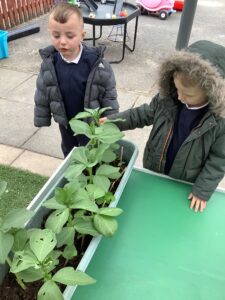

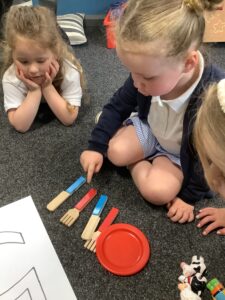

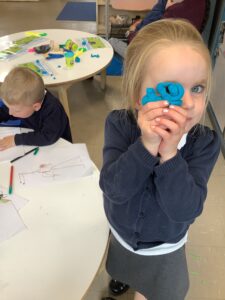
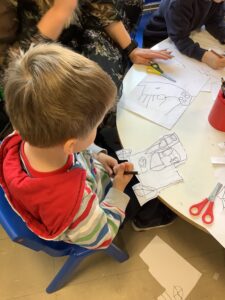



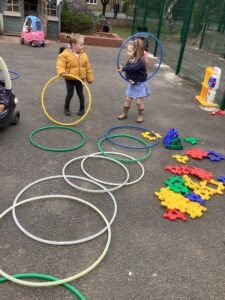

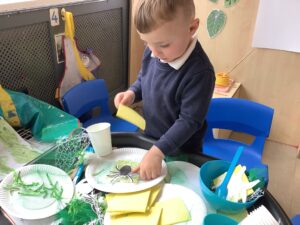
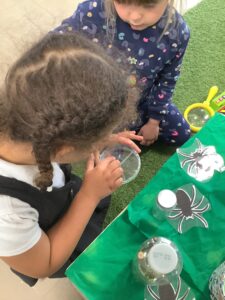


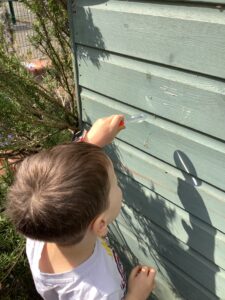
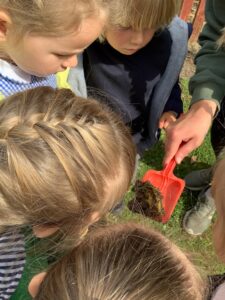



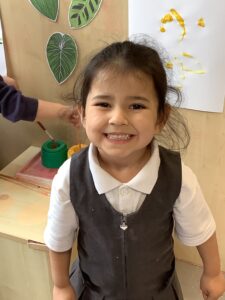
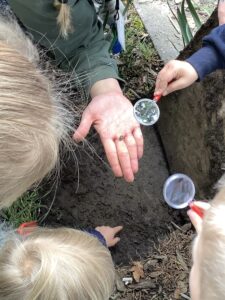
Our biology experiment!
This week in years 3 and 4 we have continued our learning about plants. We carried our an experiment to investigate how much water cress requires to grow. We planted our seeds and then poured different amounts of water in each pot. We will keep observing the cress by measuring it every two days. 


This week’s message (Friday 29 April 2022)
This half-term, your child is a geographer. This week’s message, from Mr Wilks, our Sphere Federation Topic Leader, helps you to support your child at home…
However, before we dive right in, here’s a reminder about topics and what they look like.
What do we mean by topics?
Topics are the vehicle for delivering much of the learning in the foundation subjects (eg History, Art, Geography, DT). Each half-termly topic has a driving subject – the main focus for teaching pupils the knowledge and skills they need to succeed in life. The driver changes with each topic to ensure a broad and balanced curriculum.
Although the learning in each topic is provided by the driving subject, there are opportunities for enrichment through other subjects. For example, learning in a history driven subject may be enriched by observational drawing of an artefact. In this example, the enricher is art.
For more information about the intent, implementation and impact of our topics, click here.
What is this half-term’s topic?
This half-term, we’re geographers. The topic is called Explorers.
We’re comparing a place in the United Kingdom with a place in another country. Y1,2 children are heading to Kenya in Africa; Y3,4 children are having a mini-break in Venice; and Y5,6 children are trekking through the Amazon Rainforest in South America.
Across the year groups, children are developing their understanding of some key geographical concepts:
- Space is a precise location, eg a country, city a latitude or longitude.
- Place = location + meaning. This includes the physical and human geography that make a place unique. Importantly, place is not rigid. It is changing and can be perceived in different ways.
- Scale is defined by the relative sizes of places. This could be differences in area, population, distances. Scale can also be defined by our view of the world. For example, we may consider an aspect of geography on a local, national and international scale.
- Interdependence is the idea that the world is connected and that countries or individuals do not act in isolation. Our actions here affect people in different countries around the world. For example, food, energy, holidays, climate.
Click this link to the Curriculum Statement for more information about key concepts (page 19) and age-related expectations and vocabulary (page 22 and 23).
Years 1 and 2
Children begin the topic by learning about the different continents and oceans in the world. They learn about the Equator and how it splits the Earth into two hemispheres. They then focus on a specific continent, Africa, and a specific country within that continent, Kenya. They compare Nairobi in Kenya to London, with a focus on the physical and human geography of these two places. Finally, they take a visit into the countryside and compare features of the Yorkshire Dales with a National Park just outside Nairobi.
Years 3 and 4
Children recap learning about the Equator and hemispheres. They then develop that by learning about the tropics and climate zones. A focus on European and world cities and countries follows; this links to climate zone learning. After that, they focus in on Venice in Italy and its physical and human geography which they compare with York. They’ll learn about the positives and benefits that tourism brings, putting themselves in the shoes of both tourists visiting the places and locals who live there. Finally, they’ll learn about the problems posed by flooding in both localities and the solutions they have introduced to limit the consequences of flooding.
Years 5 and 6
We begin the topic by learning about the different types of biomes found on Earth and how these are linked to climate. Children then focus on the biomes found in Brazil and the UK. They then focus on Brazil more generally, building their understanding of it as a place. Next, they learn about the Amazon Rainforest and its importance to Brazil in terms of the economy as well as its importance ecologically. They’ll learn about the threats to the rainforest and the impact that deforestation is having. Finally, children consider what Brazil – and we – need to do to slow down deforestation and what we can do to slow deforestation.
How can you help?
Regardless of the year group your child is in, Google Earth is a brilliant tool to help develop children’s understanding of space, place, scale and interdependence. Zoom right in on your home and then zoom out to reveal the area of Leeds that you live in. Zoom further out to see what city you live. Zoom further for the county. A little further and you might start to spot some national parks. Further still and you can see the country that we live in. Keep zooming and you’ll see the continent we live in (though this isn’t labelled). Before you know it, you’re floating in space and circling the Earth!
Google Maps is another great tool for comparing places. Try the street view option and you can walk along a street in Nairobi and a street in London. Take a drive through the lush Yorkshire Dales and compare this to the Kenyan countryside. You could wander down the Shambles in York and compare this to the streets in Venice. You can also compare images of the same street from different points in time.
Quizzing your children about some locational knowledge will help them to remember important information. I’ve listed some examples below. Use the age-related expectations (see the links to our Curriculum Statement, above) to find the right pitch for your child.
- Which continent do we live in?
- Which country do we live in?
- In which hemisphere is our country located?
- Which county do we live in?
- Which city do we live in?
- Which part of Leeds do we live in?
- Which four countries make up the United Kingdom?
If you can, go to the library and get some geography-related books, especially an atlas. You could compare maps of the same place to see what type of information they show. For example, you find lots of maps of the United Kingdom. One might show the countries and capital cities. Another might show the mountains, rivers and national parks. Another might give information about the climate.
For older children, there are lots of different games and activities on the Ordnance Survey Mapzone website. I especially like the jigsaws in the Map Puzzles section of the Games!
Also for children in Key Stage 2, there are lots of information and some tasks and quizzes on the BBC Bitesize website.